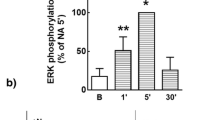Summary
Agonist binding to various hormone receptors mediating adenylate cyclase inhibition is decreased by sodium ions. We studied the influence of Na+ on agonist and antagonist binding to β-adrenoceptors in membrane preparations of guinea pig lung, S49 lymphoma wild-type cells (WT) and their Ns-deficient cyc− variants by measuring binding of the antagonist, [125I]iodocyanopindolol ([125I]CYP). At 37° C, sodium decreased the receptor affinity for the agonist, isoproterenol, in all three membrane preparations. In lung and WT membranes, Na+ steepened the shallow agonist competition curves in a manner similar to and synergistic with guanine nucleotides. When binding was performend at 4° C, sodium regulation but not guanine nucleotide regulation of agonist binding was preserved. At the low temperature, [125I]CYP affinity was reduced, and sodium increased [125I]CYP binding in both Ns-containing and Ns-deficient membranes by increasing the antagonist affinity without significant change in total receptor number. Compared to Na+, Li+ and K+ were much less potent and efficient in decreasing agonist and increasing antagonist binding. Na+ and Mg2+ had opposite effects on agonist binding in the Ns-containing lung and WT membranes but not in the Ns-deficient cyc− membranes. The data indicate that sodium not only regulates binding of inhibitory hormone receptors but also agonist and antagonist binding to the adenylate cyclase stimulatory β-adrenoceptor. The finding that sodium regulation of β-adrenoceptor binding is also observed in the Ns α2 cyc− membranes, furthermore, indicates that the target of sodium is not the α-subunit of Ns but possibly a component common to both types of receptor systems regulating adenylate cyclase activity.
Similar content being viewed by others
References
Aktories K, Hungerer KD, Robbel L, Jakobs KH (1984) Mechanisms and structural requirements of pertussis toxin action on adenylate cyclase. In: Abstract volume, 9th International Congress of Pharmacology. Macmillan Press, London, p 1655
Briggs MM, Lefkowitz RJ (1980) Parallel modulation of catecholamine activation of adenylate cyclase and formation of the high-affinity agonist receptor complex in turkey erythrocyte membranes by temperature and cis-vaccenic acid. Biochemistry 19:4461–4466
Brodde OE, Kuhlhoff F, Arroyo J, Prywarra A (1983) No evidence for temperature-dependent changes in the pharmacological specificity of β1- and β2-adrenoceptors in rabbit lung membranes. Nanyn-Schmiedeberg's Arch Pharmacol 322:20–28
Cheng Y, Prusoff WH (1973) Relationship between the inhibition constant (K 1)and the concentration of inhibitor which causes 50% inhibition (IC50) of an enzymatic reaction. Biochem Pharmacol 22:3099–3108
Heidenreich KA, Weiland GA, Molinoff PB (1980) Characterization of radiolabeled agonist binding to β-adrenergic receptors in mammalian tissues. J Cyclic Nucleotide Res. 6:217–230
Jakobs KH, Gehring U, Gaugler B, Pfeuffer T, Schultz G (1983) Occurrence of an inhibitory guanine nucleotide-binding regulatory component of the adenylate cyclase system in cyc− variants of S49 lymphoma cells. Eur J Biochem 130:605–611
Jakobs KH, Minuth M, Aktories K (1984) Sodium regulation of hormone-sensitive adenylate cyclase. J Recept Res 4:443–458
Kleinstein J, Glossmann H (1978) Solubilisation of a mammalian β-adrenergic receptor. Naunyn-Schmiedeberg's Arch Pharmacol 305:191–200
Limbird LE, Speck JL (1983) N-Ethylmaleimide, elevated temperature, and digitonin solubilization eliminate guanine nucleotide but not sodium effects on human platelet α2-adrenergic receptor-agonist interactions. J Cyclic Nucleotide Protein Phosphorylation Res 9:191–202
Limbird LE, Speck JL, Smith SK (1982) Sodium ion modulates agonist and antagonist interactions with the human platelet alpha2-adrenergic receptor in membrane and solubilized preparations. Mol Pharmacol 21:609–617
Lowry OH, Rosebrough NJ, Farr AL, Randall RJ (1951) Protein measurement with the Folin phenol reagent. J Biol Chem 193:265–275
Manning DR, Gilman AG (1983) The regulatory components of adenylate cyclase and transducin. A family of structurally homologous guanine nucleotide-binding proteins. J Biol Chem 258:7079–7063
Martin MW, Smith MM, Harden TK (1984) Modulation of muscarinic cholinergic receptor affinity for antagonists in rat heart. J Pharmacol Exp Ther 230:424–430
Michel T, Hoffman BB, Lefkowitz RJ (1980) Differential regulation of the α2-adrenergic receptor by Na+ and guanine nucleotides. Nature 288:709–711
Northup JK, Sternweis PC, Gilman AG (1983) The subunits of the stimulatory regulatory component of adenylate cyclase. Resolution, acitivity, and properties of the 35,000-dalton (β) subunit. J Biol Chem 258:11361–11368
Pert CB, Snyder SH (1974) Opiate receptor binding of agonists and antagonists affected differentially by sodium. Mol Pharmacol 10:868–879
Rosenberger LB, Yamamura HI, Roeske WR (1980) Cardiac muscarinic receptor binding is regulated by Na+ and guanyl nucleotides. J Biol Chem 255:820–823
Ross EM, Maguire ME, Sturgill TW, Biltonen RL, Gilman AG (1977) Relationship between the β-adrenergic receptor and adenylate cyclase. Studies of ligand binding and enzyme activity in purified membranes of S49 lymphoma cells. J Biol Chem 252:5761–5775
Scatchard G (1949) The attraction of proteins for small molecules and ions. Ann NY Acad Sci 51:660–672
Tsai BS, Lefkowitz RJ (1978) Agonist-specific effects of monovalent and divalent cations on adenylate cyclase-coupled alpha adrenergic receptors in rabbit platelets. Mol Pharmacol 14:540–548
Ui M, Katada T, Murayama T, Kurose H, Yajima M, Tamura M, Nakamura T, Nogimori K (1984) Islet-activating protein, pertussis toxin: A specific uncoupler of receptor-mediated inhibition of adenylate cyclase. Adv Cyclic Nucleotide Protein Phosphorylation Res 17:145–151
U'Prichard DC, Bylund DB, Snyder SH (1978) (−)-(3H)-Epinephrine and (−)-(3H) dihydroalprenolol binding to β1- and β2-adrenergic receptors in brain, heart and lung membranes. J Biol Chem 253:5090–5102
Weiland GA, Minneman KP, Molinoff PB (1979) Fundamental difference between the molecular interactions of agonist and antagonist with the β-adrenergic receptor. Nature 281:114–117
Weiland GA, Minneman KP, Molinoff PB (1980) Thermodynamics of agonist and antagonist interactions with mammalian β-adrenergic receptors. Mol Pharmacol 18:341–347
Wüster M, Costa T, Aktories K, Jakobs KH (1984) Sodium regulation of opioid agonist binding is potentiated by pertussis toxin. Biochem Biophys Res Commun 123:1107–1115
Author information
Authors and Affiliations
Rights and permissions
About this article
Cite this article
Minuth, M., Jakobs, K.H. Sodium regulation of agonist and antagonist binding to β-adrenoceptors in intact and Ns-deficient membranes. Naunyn-Schmiedeberg's Arch. Pharmacol. 333, 124–129 (1986). https://doi.org/10.1007/BF00506514
Received:
Accepted:
Issue Date:
DOI: https://doi.org/10.1007/BF00506514




